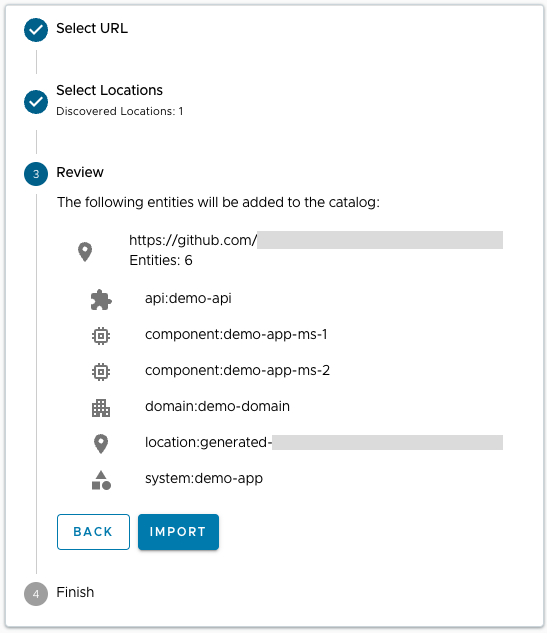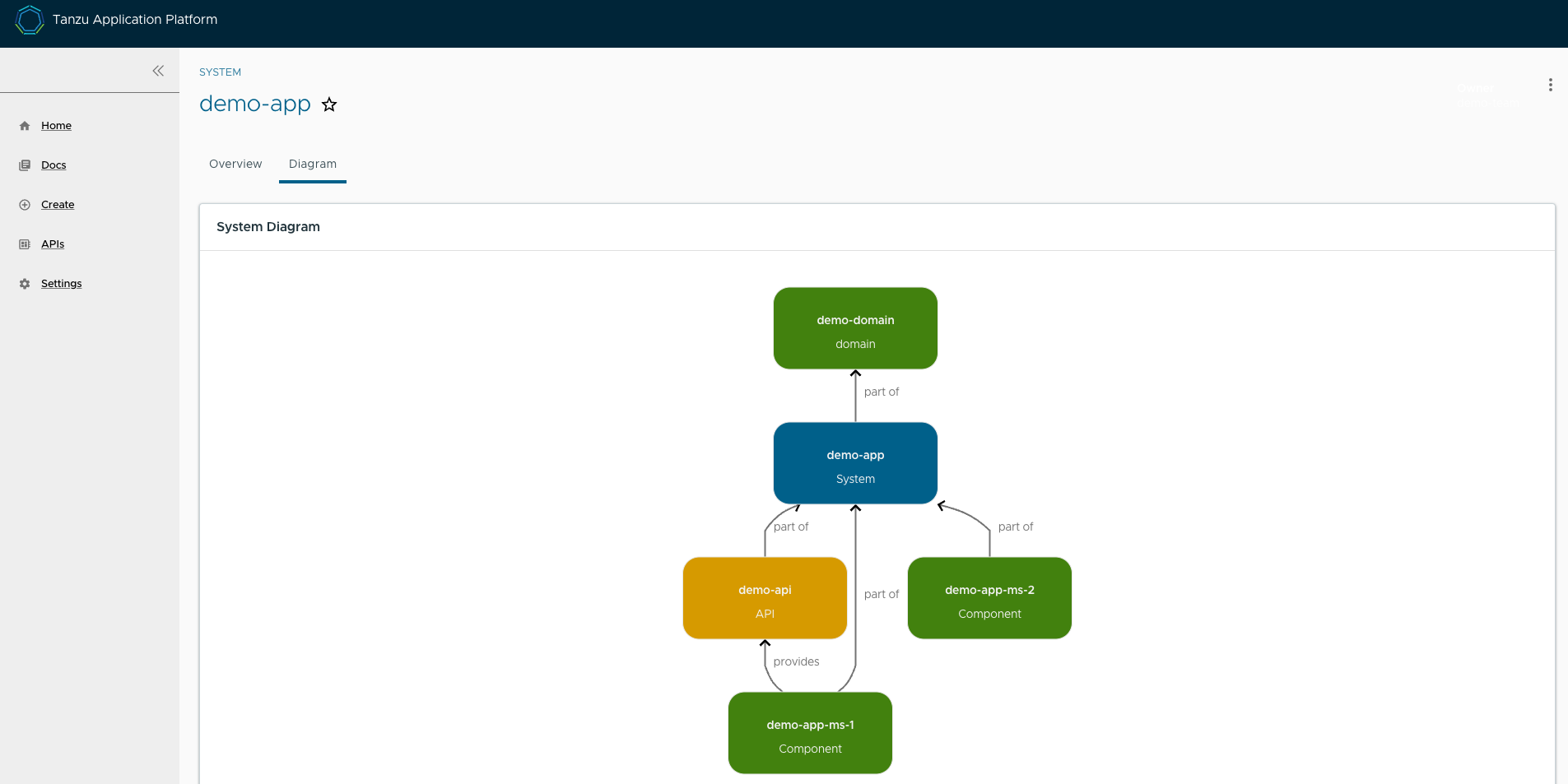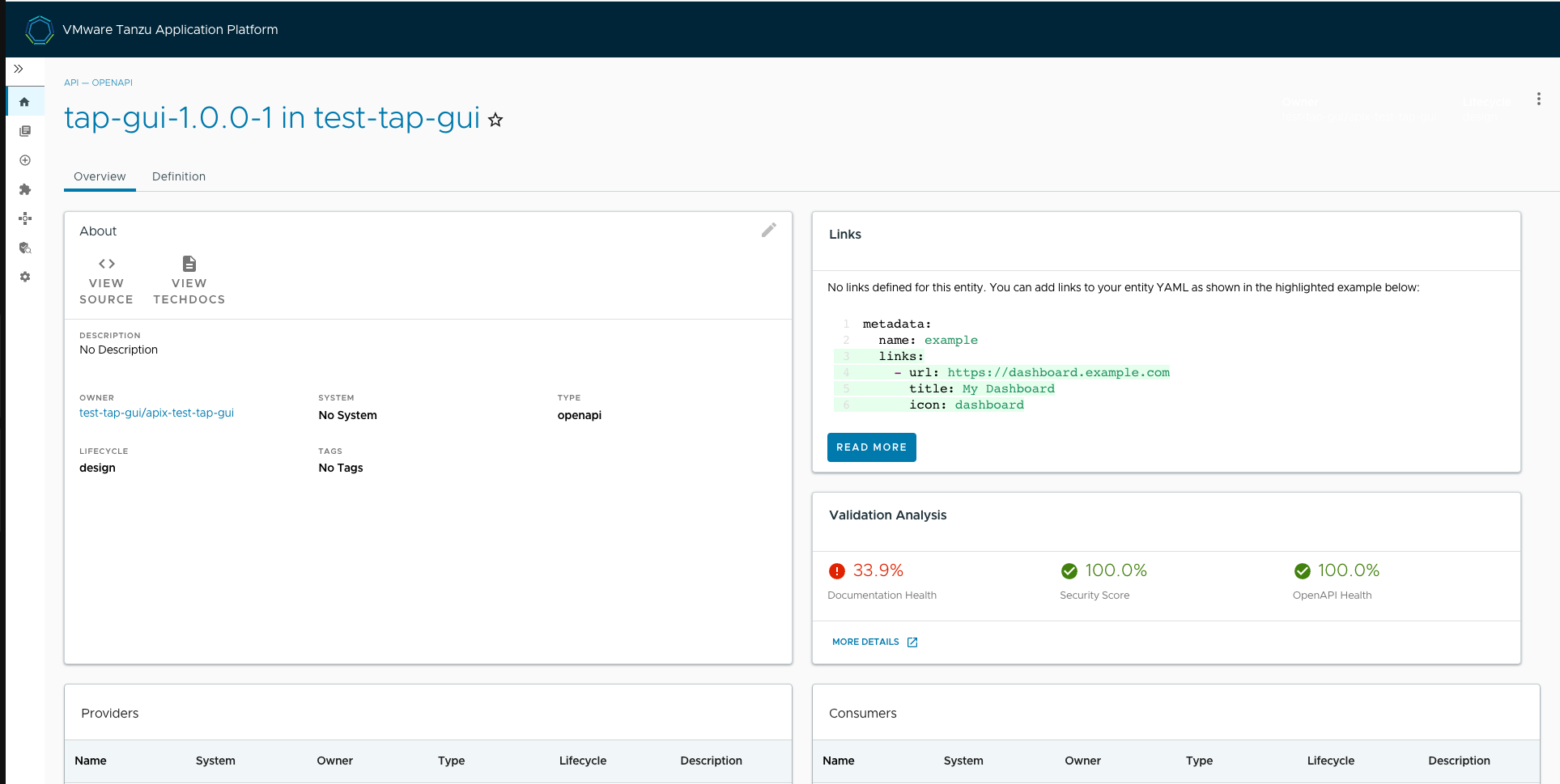Get started with the API documentation plug-in
This topic tells you how to get started with the API documentation plug-in in Tanzu Developer Portal.
API entries
This section describes API entities, how to add them, and how to update them.
About API entities
The list of API entities is visible on the left side navigation pane of Tanzu Developer Portal. It is also visible on the Overview page of specific components on the home page. APIs are a definition of the interface between components.
Their definition is provided in raw machine-readable and human-readable formats. For more information, see the API plug-in documentation.
Add a demo API entity to the Tanzu Developer Portal software catalog
To add a demo API entity and its related Catalog objects, follow the steps used for registering any other software catalog entity:
-
Go to the Home page of Tanzu Developer Portal by clicking Home on the left-side navigation pane.
-
Click REGISTER ENTITY.
-
In the repository URL text box, type the link to the
catalog-info.yamlfile of your choice or use the following sample definition. -
Save this code block as
catalog-info.yaml. -
Upload it to the Git repository of your choice and copy the link to
catalog-info.yaml. This demo setup includes a domain nameddemo-domainwith a single system nameddemo-system. This systems consists of two microservices (demo-app-ms-1anddemo-app-ms-1) and one API nameddemo-apithatdemo-app-ms-1provides and thatdemo-app-ms-2consumes.apiVersion: backstage.io/v1alpha1 kind: Domain metadata: name: demo-domain description: Demo Domain for Tanzu Application Platform annotations: 'backstage.io/techdocs-ref': dir:. spec: owner: demo-team --- apiVersion: backstage.io/v1alpha1 kind: Component metadata: name: demo-app-ms-1 description: Demo Application's Microservice-1 tags: - microservice annotations: 'backstage.io/kubernetes-label-selector': 'app.kubernetes.io/part-of=demo-app-ms-1' 'backstage.io/techdocs-ref': dir:. spec: type: service providesApis: - demo-api lifecycle: alpha owner: demo-team system: demo-app --- apiVersion: backstage.io/v1alpha1 kind: Component metadata: name: demo-app-ms-2 description: Demo Application's Microservice-2 tags: - microservice annotations: 'backstage.io/kubernetes-label-selector': 'app.kubernetes.io/part-of=demo-app-ms-2' 'backstage.io/techdocs-ref': dir:. spec: type: service consumesApis: - demo-api lifecycle: alpha owner: demo-team system: demo-app --- apiVersion: backstage.io/v1alpha1 kind: System metadata: name: demo-app description: Demo Application for Tanzu Application Platform annotations: 'backstage.io/techdocs-ref': dir:. spec: owner: demo-team domain: demo-domain --- apiVersion: backstage.io/v1alpha1 kind: API metadata: name: demo-api description: The demo API for Tanzu Developer Portal links: - url: https://api.agify.io title: API Definition icon: docs spec: type: openapi lifecycle: experimental owner: demo-team system: demo-app # Or specify system name of your choice definition: | openapi: 3.0.1 info: title: Demo API description: defaultDescription version: '0.1' servers: - url: https://api.agify.io paths: /: get: description: Auto generated using Swagger Inspector parameters: - name: name in: query schema: type: string example: type_any_name responses: '200': description: Auto generated using Swagger Inspector content: application/json; charset=utf-8: schema: type: string examples: {} -
Paste the link to
catalog-info.yamland click ANALYZE. -
Review the catalog entities and click IMPORT.

-
Go to the API page by clicking APIs on the left side navigation pane. The catalog changes and entries are visible for further inspection. If you select the system demo-app, the diagram appears as follows:

Update your demo API entry
To update your demo API entry, click demo-api in the list of available APIs in your software catalog and click the Edit icon on the Overview page.
It opens the source catalog-info.yaml file that you can edit. For example, you can change the spec.paths.parameters.example from type_any_name to Tanzu and then save your changes.
After making any edits, Tanzu Developer Portal re-renders the API entry with the next refresh cycle.
Validation Analysis of API specifications
This section describes the Validation Analysis card, the data format needed to populate the card, and how to get automatic scores for your OpenAPI entities.
About the Validation Analysis card
When viewing entities of the kind API on the Overview tab, you see the Validation Analysis card that displays the health of an API through various scoring parameters.

To display the health scores, an API entity must contain the following metadata structure:
apiVersion: backstage.io/v1alpha1
kind: API
metadata:
name: NAME
description: DESCRIPTION
apiscores:
scores:
- id: documentationReport
label: "Documentation Health"
value: 34.375
valueType: percentage
status: failed
- id: securityReport
label: "Security Score"
value: 70.0
valueType: percentage
status: warning
- id: openApiHealthReport
label: "OpenAPI Health"
value: 89.0625
valueType: percentage
status: passed
scoreDetailsURL: VALIDATION-REPORT-URL-FOR-MORE-DETAILS
# Other API Entity parameters
If an API entity follows this schema, the Validation Analysis card displays helpful information about the API.
- id: # Unique ID
label: # Descriptive label displayed as a title over the numerical value
value: # Any number value
valueType: # One of the types (percentage or other). Displays the % symbol or displays nothing.
status: # One of the statuses (passed, warning, or failed). Displays the number in green, yellow, or red.